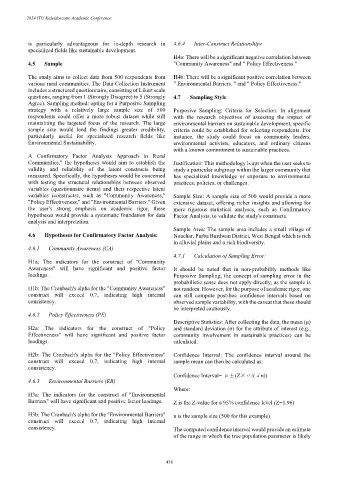Page 482 - Kaleidoscope Academic Conference Proceedings 2024
P. 482
2024 ITU Kaleidoscope Academic Conference
is particularly advantageous for in-depth research in 4.6.4 Inter-Construct Relationships
specialized fields like sustainable development.
H4a: There will be a significant negative correlation between
4.5 Sample "Community Awareness" and " Policy Effectiveness "
The study aims to collect data from 500 respondents from H4b: There will be a significant positive correlation between
various rural communities. The Data Collection Instrument " Environmental Barriers. " and " Policy Effectiveness."
includes a structured questionnaire, consisting of Likert scale
questions, ranging from 1 (Strongly Disagree) to 5 (Strongly 4.7 Sampling Style
Agree). Sampling method: opting for a Purposive Sampling
strategy with a relatively large sample size of 500 Purposive Sampling: Criteria for Selection: In alignment
respondents could offer a more robust dataset while still with the research objectives of assessing the impact of
maintaining the targeted focus of the research. The large environmental barriers on sustainable development, specific
sample size would lend the findings greater credibility, criteria could be established for selecting respondents. For
particularly useful for specialized research fields like instance, the study could focus on community leaders,
Environmental Sustainability. environmental activists, educators, and ordinary citizens
with a known commitment to sustainable practices.
A Confirmatory Factor Analysis Approach in Rural
Communities," the hypotheses would aim to establish the Justification: This methodology is apt when the user seeks to
validity and reliability of the latent constructs being study a particular subgroup within the larger community that
measured. Specifically, the hypotheses would be concerned has specialized knowledge or exposure to environmental
with testing the structural relationships between observed practices, policies, or challenges.
variables (questionnaire items) and their respective latent
variables (constructs), such as "Community Awareness," Sample Size: A sample size of 500 would provide a more
"Policy Effectiveness," and "Environmental Barriers." Given extensive dataset, offering richer insights and allowing for
the user's strong emphasis on academic rigor, these more rigorous statistical analyses, such as Confirmatory
hypotheses would provide a systematic foundation for data Factor Analysis, to validate the study's constructs.
analysis and interpretation.
Sample Area: The sample area includes a small village of
4.6 Hypotheses for Confirmatory Factor Analysis: Noachar, Purba Burdwan District, West Bengal which is rich
in alluvial plains and a rich biodiversity.
4.6.1 Community Awareness (CA)
4.7.1 Calculation of Sampling Error:
H1a: The indicators for the construct of "Community
Awareness" will have significant and positive factor It should be noted that in non-probability methods like
loadings. Purposive Sampling, the concept of sampling error in the
probabilistic sense does not apply directly, as the sample is
H1b: The Cronbach's alpha for the "Community Awareness" not random. However, for the purpose of academic rigor, one
construct will exceed 0.7, indicating high internal can still compute post-hoc confidence intervals based on
consistency. observed sample variability, with the caveat that these should
be interpreted cautiously.
4.6.2 Policy Effectiveness (PE)
Descriptive Statistics: After collecting the data, the mean (μ)
H2a: The indicators for the construct of "Policy and standard deviation (σ) for the attribute of interest (e.g.,
Effectiveness" will have significant and positive factor community involvement in sustainable practices) can be
loadings. calculated.
H2b: The Cronbach's alpha for the "Policy Effectiveness" Confidence Interval: The confidence interval around the
construct will exceed 0.7, indicating high internal sample mean can then be calculated as:
consistency.
Confidence Interval= μ±(Z×σ/(√n))
4.6.3 Environmental Barriers (EB)
Where:
H3a: The indicators for the construct of "Environmental
Barriers" will have significant and positive factor loadings. Z is the Z-value for a 95% confidence level (Z=1.96)
H3b: The Cronbach's alpha for the "Environmental Barriers" n is the sample size (500 for this example)
construct will exceed 0.7, indicating high internal
consistency. The computed confidence interval would provide an estimate
of the range in which the true population parameter is likely
– 438 –

